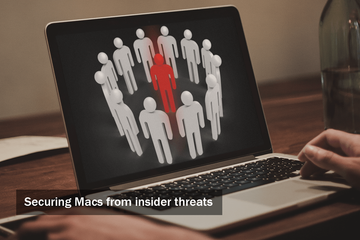Enterprises are increasingly switching to Macs. In 2021, research from IDC revealed that Macs have a 23% US enterprise market share, up from 17% two years earlier. And for a good reason: research from Forrester found that employees using Macs were 20% more likely to stay with their company.
However, with increased use comes increased risk. While Apple devices are typically better protected from cybercrime than their Windows or Linux counterparts, this is not the case with insider threats; this is because, when it comes to insider threats, organizations and their employees are responsible for security, not the device.
This article will outline insider threats and how to secure Macs against them.
What is an Insider Threat?
An insider threat is a security risk involving someone inside the targeted organization. They can include current and former employees, business partners, contractors, or anyone else that could be considered a company insider.
There are three primary types of insider threats:
- Malicious Insider – A malicious insider is often a disgruntled employee who deliberately abuses their position for personal gain.
- Accidental Insider – Accidental insiders are the most common form of insider threat. They are people who unwittingly expose their organization’s private information or sensitive systems to an outside threat. Be it clicking a suspicious link, falling victim to a social engineering scam, or losing a company device, accidental insiders, as the same suggests, become an insider threat by mistake.
- The Mole – A mole masquerades as a legitimate employee or partner to gain access to privileged information or networks. Unlike malicious insiders, moles typically join an organization for the sole purpose of stealing from them.
Securing Macs from Insider Threats
Now that you understand what an insider threat is and the forms it can take, you need to think about how to secure your enterprise Macs against them.
Below are some fundamental guidelines and best practices for protecting Macs from insider threats.
- Access Control and User Management:
- Implementing complex passwords, biometric authentication (Touch ID or Face ID), or multi-factor authentication (MFA) will ensure unauthorized users cannot access privileged information.
- Granting user access privileges based on the principle of least privilege means that users only have access to the resources necessary for their roles and responsibilities.
- Regularly reviewing and updating user access rights will ensure that organizations remove former employees or users who no longer require access.
- Data Classification and Encryption:
- Classifying sensitive data based on its importance and confidentiality level will lower the risk of false positives and allow security teams to focus on legitimate threats.
- Encrypting data will secure it in rest and transit. macOS provides FileVault for full disk encryption, which safeguards data even if the physical device is lost or stolen.
- Ensuring employees use secure communication channels, such as encrypted email and file-sharing platforms, as well as a VPN connection, will prevent them from exposing sensitive data.
- Endpoint Protection and Monitoring:
- Deploying robust endpoint protection solutions, including antivirus and anti-malware software, will help detect and prevent insider threats from stealing information.
- Enabling firewall settings on Macs will restrict unauthorized network access.
- Implementing intrusion detection and prevention systems (IDS/IPS) to monitor and identify suspicious behavior will prevent the final stages of an insider threat.
- Employee Awareness and Training:
- Conducting regular security awareness training to educate employees about insider threats, their consequences, and how to identify and report potential incidents will reduce the risk of accidental insider threats and empower staff to report suspicious behavior.
- Fostering a positive security culture by promoting ethical behavior, emphasizing the importance of data protection, and maintaining a clear policy on the acceptable use of company resources reduces the risk of accidental insiders.
- Logging and Auditing:
- Enabling comprehensive logging on Mac systems captures user activities, system events, and security-related incidents, establishes a baseline of normal behavior, and allows organizations to identify any abnormalities.
- Deploying a user behavior and entity analytics (UEBA) solution will allow organizations to identify suspicious behavior and flag it to security teams.
- Incident Response and Investigation:
- Establishing an incident response plan that outlines the necessary steps in the event of a suspected insider threat incident allows for effective and efficient incident response.
- Defining roles and responsibilities for incident response team members prevents any confusion in the event of an insider threat.
Securing Macs from insider threats is one of the most important considerations for organizations that use Macs in their enterprise environments. While Macs are generally more secure than other operating systems, this doesn’t translate to insider threats. Understanding insider threats and implementing proper security measures is vital for protecting sensitive information.
Protecting Macs from insider threats relies on following the best practices listed above. However, organizations should remember that protecting Macs from insider threats is a constant process – keeping abreast of the evolving threat landscape and transferring this knowledge to insider threat prevention tactics is of utmost importance.

About the Author:
Josh is a Content writer at Bora. He graduated with a degree in Journalism in 2021 and has a background in cybersecurity PR. He's written on a wide range of topics, from AI to Zero Trust, and is particularly interested in the impacts of cybersecurity on the wider economy.
